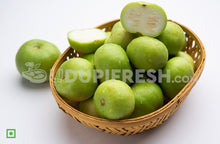Tinda, scientifically known as Praecitrullus fistulosus, is a unique vegetable that holds a cherished place in Indian cuisine. Belonging to the gourd family, it's also commonly referred to as Indian squash, round melon, or apple gourd due to its small, round shape resembling an apple. This vegetable is primarily cultivated in the Indian subcontinent, though it's also found in other parts of Asia.
Tinda features a smooth, light green skin and white flesh with small seeds embedded in the center. Its flavor is mild and slightly sweet, reminiscent of a cross between zucchini and cucumber. The tender texture of tinda makes it versatile for cooking, as it readily absorbs flavors from spices and other ingredients.
In Indian culinary traditions, tinda is used in a variety of dishes, particularly in North Indian cuisine. It's commonly incorporated into curries, stir-fries, and stuffed recipes. One popular preparation is "Bharwa Tinda," where the vegetable is hollowed out and filled with a spiced mixture before being cooked. Another favorite is "Tinda Masala," a curry made by simmering tinda with onions, tomatoes, and a blend of aromatic spices.
Nutritionally, tinda offers several health benefits. It's low in calories and rich in dietary fiber, making it a good choice for those looking to manage their weight or improve digestive health. Additionally, tinda is a good source of vitamins A and C, as well as minerals like calcium, potassium, and magnesium.
Despite its popularity in Indian cuisine, tinda is relatively lesser-known outside of South Asia. However, its mild flavor, versatility, and nutritional profile make it a vegetable worth exploring for those seeking to diversify their culinary experiences. Whether enjoyed in traditional Indian recipes or incorporated into innovative dishes, tinda undoubtedly adds a delightful touch to the dining table.








